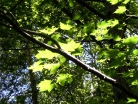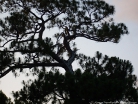


Pacific Yew (Taxus brevifolia Nutt.) is a long lived conifer in the Yew family. It usually grows between 20-40 feet, occasionally up to 75, and 1-2 feet in diameter. The bark is reddish purple and flakes off in irregular, thin patches. Flowers bloom
early summer, producing male and female cones on separate trees. Eventually, they develop into fleshy,
red ...more
early summer, producing male and female cones on separate trees. Eventually, they develop into fleshy,
red ...more

photo citation © 1995 Saint Mary's College of California

The Yew family consists mainly of evergreen shrubs and small trees with flat, linear needles. They are also gymnosperms meaning they bear naked seeds. The foliage and seeds of members in the Yew family are extremely poisonous both to people and livestock, and as such, care should be taken to ensure livestock cannot browse on Yew species. In both the past and modern times, people have died from eating the seeds and consuming teas made from the leaves. Yew trees are prized as ornamentals and for their wood, particularly in bow making.

Yew Family Trees of California

Want to add your tree to our picture gallery? Click here for details!
-Color denotes a tree that is rare or endangered

Pacific Yew (Taxus brevifolia Nutt.)
Height: 20-40 ft
Diameter: 1-2 ft
Showy flower: no
Fall colors: no-evergreen
Drought tolerant: medium
Annual rainfall: 24-60
Soil Needs: moist, rich, well-draining
Frost Free Days: 140
Minimum Temperature (F): -18
Growth Rate:
State List: AK, CA, ID, MT, NV, OR,
WA ...more
Height: 20-40 ft
Diameter: 1-2 ft
Showy flower: no
Fall colors: no-evergreen
Drought tolerant: medium
Annual rainfall: 24-60
Soil Needs: moist, rich, well-draining
Frost Free Days: 140
Minimum Temperature (F): -18
Growth Rate:
State List: AK, CA, ID, MT, NV, OR,
WA ...more
To visit other tree families for California, select it here:
Click to enlarge


™

|
|
|
|
|
| A-Z scientific | ||
| A-Z by Common Name | ||
| Families | ||
| Browse by State | ||
| Rare or Endangered Species | ||
| Trees_with_Special_Uses | ||
| Tallest and Biggest |
| Aceraceae Maple Family | ||
| Anacardiaceae Sumac Family | ||
| Annonaceae Custard Apple Family | ||
| Aquifoliaceae Holly Family | ||
| Arecaceae, Palm Family | ||
| Betulaceae Birch family | ||
| Bignoniaceae Trumpet Creeper Family | ||
| Burseraceae Frankincense Family | ||
| Caprifoliaceae Honeysuckle Family | ||
| Chrysobalanaceae Coco-plum Family | ||
| Cornaceae Dogwood Family | ||
| Cupressaceae Cypress Family | ||
| Cyrillaceae Cyrilla Family | ||
| Ebenaceae Ebony Family | ||
| Ericaceae Heath Family | ||
| Fabaceae Pea Family | ||
| Fagaceae Beech Family | ||
| Hamamelidaceae Witch Hazel Ffamily | ||
| Hippocastanaceae Horse Chestnut Family | ||
| Juglandaceae Walnut Family | ||
| Lauraceae Laurel Family | ||
| Leitneriaceae Corkwood Family | ||
| Magnoliaceae Magnolia Family | ||
| Meliaceae Mahogany Family | ||
| Moraceae Mulberry Family | ||
| Myricaceae Bayberry Family | ||
| Myrsinaceae Myrsine Family | ||
| Myrtaceae Myrtle Family | ||
| Nyctaginaceae Four Oclock Family | ||
| Olacaceae Olax Family | ||
| Oleaceae Olive Family | ||
| Pinaceae Pine Family | ||
| Platanaceae Plane Tree Family | ||
| Polygonaceae Buckwheat Family | ||
| Rhamnaceae Buckthorn Family | ||
| Rosaceae Rose Family | ||
| Rubiaceae Madder Family | ||
| Rutaceae Rue Family | ||
| Salicaceae Willow Family | ||
| Sapindaceae Soapberry Family | ||
| Sapotaceae Sapodilla Family | ||
| Simaroubaceae Quassia Family | ||
| Styracaceae Storax Family | ||
| Symplocaceae Sweetleaf Family | ||
| Theaceae Tea Family | ||
| Tiliaceae Lindon Family | ||
| Ulmaceae Elm Family | ||
| Taxaceae Yew Family | ||
| Yucca Family |
| Maple A-Z |
| sumac_family_a-z |
| custard_apple_family_a-z |
| holly_trees_a-z |
| palm_family_a-z |
| birch_family_a-z |
| trumpet_creeper_family_a-z |
| honeysuckle_family_a-z |
| dogwood_family_a-z |
| cypress_family_a-z |
| heath_family_a-z |
| pea_family_a-z |
| beech_family_a-z |
| walnut_family_a-z |
| magnolia_family_a-z |
| olive_family_a-z |
| rose_family_a-z |
| willow_family_a-z |
| franklinia |
| elm_family_a-z |
| Federal List | ||
| State Lists | ||
| Invasive_species |
| Restoration of the American Chestnut | ||
| Restoration of the American Elm | ||
| Sustainable Forestry |
| Contact Us | ||
| Our Contributors | ||
| Photo of the Month | ||
| Usage Requirements | ||
| FAQ | ||
| Report a Broken Link |
| photo_submission |
| Photo Store |


California
The Golden State, 'Eureka! (I have found it!)'
Saturday, May 24, 2025

Custom Search
Tree lists:
•A-Z by scientific
name
•A-Z by common
name
•By Family
For state A-Z list click state name below.
•A-Z by scientific
name
•A-Z by common
name
•By Family
For state A-Z list click state name below.
Native Yew Family Trees, Taxaceae
The state distribution maps in the species info boxes below are from the USDA NRCS PLANTS Database at plants.usda.gov. In instances where state specific maps are unavailable, the US distribution map will be used in its place. Also, the PLANTS Database website states "Our county data are based primarily on the literature, herbarium specimens,
and confirmed observations. However, not all populations have been documented, so some gaps in the distribution shown above may not be real. Remember that only native and naturalized populations are mapped!"














